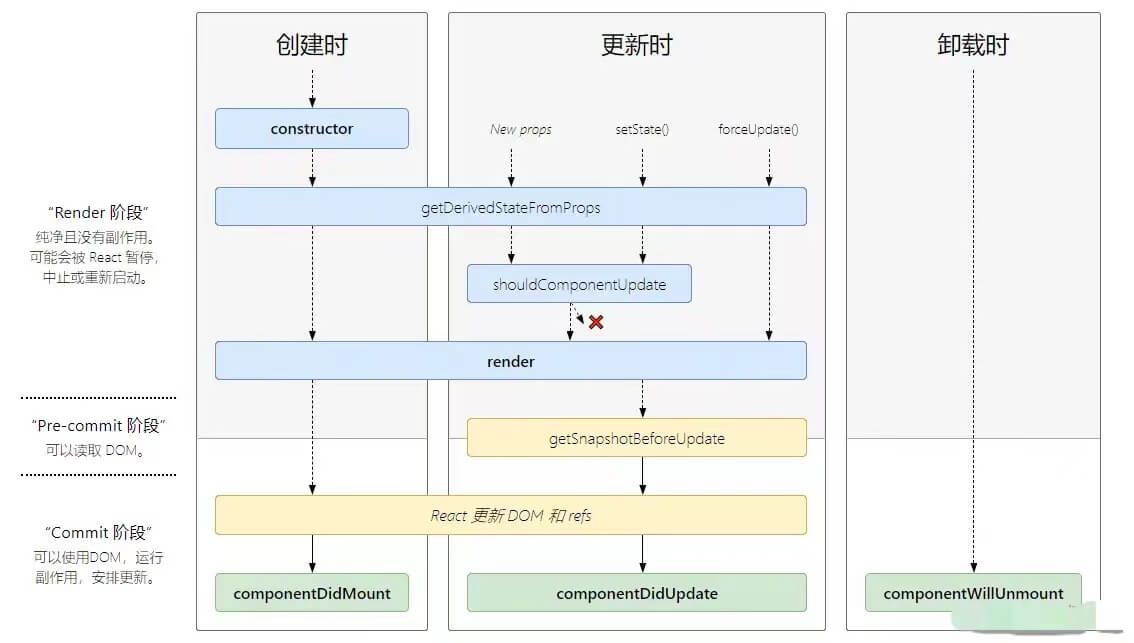React清单 - 生命周期
生命周期
Mounting(挂载):已插入真实 DOM
Updating(更新):正在被重新渲染
Unmounting(卸载):已移出真实 DOM
一、旧的生命周期:

js
// 1. 挂载
constructor
componentWillMount
render
componentDidMount
// 2. 更新
componentWillReceiveProps
shouldComponentUpdate
componentWillUpdate
render
componentDidUpdate
// 3. 卸载
componentWillUnmount二、新的生命周期:

js
// 1. 挂载
constructor
getDerivedStateFromProps
render
componentDidMount
// 2. 更新
getDerivedStateFromProps
shouldComponentUpdate
render
getSnapshotBeforeUpdate
componentDidUpdate
// 3. 卸载
componentWillUnmount三、新旧生命周期对比
js
// 1. 挂载
// 旧 ------------------------------- 新
// constructor constructor // 相同
// componentWillMount getDerivedStateFromProps // 不同
// render render // 相同
// componentDidMount componentDidMount // 相同
// 2. 更新
// 旧 ------------------------------- 新
// componentWillReceiveProps getDerivedStateFromProps // 不同
// shouldComponentUpdate shouldComponentUpdate // 相同
// componentWillUpdate // 不同
// render render // 相同
// getSnapshotBeforeUpdate // 不同
// componentDidUpdate componentDidUpdate // 相同
// 3. 卸载
// componentWillUnmount componentWillUnmount // 相同得出结论:React从v16.3开始废弃 componentWillMount componentWillReceiveProps componentWillUpdate 三个钩子函数(三个带 Will 的)。
四、父子组件生命周期的执行顺序
以 React 18 为例,结合上面的 新的生命周期 图来分析:
js
// 1. 父子组件初始化
// Parent 组件: constructor
// Parent 组件: getDerivedStateFromProps
// Parent 组件: render
// Child 组件: constructor
// Child 组件: getDerivedStateFromProps
// Child 组件: render
// Child 组件: componentDidMount
// Parent 组件: componentDidMount
// 2. 子组件修改自身状态 state
// Child 组件: getDerivedStateFromProps
// Child 组件: shouldComponentUpdate
// Child 组件: render
// Child 组件: getSnapshotBeforeUpdate
// Child 组件: componentDidUpdate
// 3. 修改父组件中传入子组件的 props
// Parent 组件: getDerivedStateFromProps
// Parent 组件: shouldComponentUpdate
// Parent 组件: render
// Child 组件: getDerivedStateFromProps
// Child 组件: shouldComponentUpdate
// Child 组件: render
// Child 组件: getSnapshotBeforeUpdate
// Parent 组件: getSnapshotBeforeUpdate
// Child 组件: componentDidUpdate
// Parent 组件: componentDidUpdate
// 4. 卸载子组件
// Parent 组件: getDerivedStateFromProps
// Parent 组件: shouldComponentUpdate
// Parent 组件: render
// Parent 组件: getSnapshotBeforeUpdate
// Child 组件: componentWillUnmount
// Parent 组件: componentDidUpdate
// 5. 重新挂载子组件
// Parent 组件: getDerivedStateFromProps
// Parent 组件: shouldComponentUpdate
// Parent 组件: render
// Child 组件: constructor
// Child 组件: getDerivedStateFromProps
// Child 组件: render
// Parent 组件: getSnapshotBeforeUpdate
// Child 组件: componentDidMount
// Parent 组件: componentDidUpdate父子组件生命周期执行顺序总结:
- 当子组件自身状态改变时,不会对父组件产生副作用的情况下,父组件不会进行更新,即不会触发父组件的生命周期
- 当父组件中状态发生变化(包括子组件的挂载以及卸载)时,会触发自身对应的生命周期以及子组件的更新
- render 以及 render 之前的生命周期,则 父组件先执行
- render 以及 render之后的声明周期,则子组件先执行,并且是与父组件交替执行
- 当子组件进行卸载时,只会执行自身的 componentWillUnmount 生命周期,不会再触发别的生命周期
DEMO验证:
父子组件生命周期的执行顺序